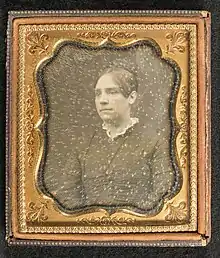Margaretta Morris
Margaretta Hare Morris (3 December 1797 – 29 May 1867) was an American entomologist.[1] Morris and the astronomer Maria Mitchell were the first women elected to the American Association for the Advancement of Science in 1850.[2][3] She was also the second woman elected to the Academy of Natural Sciences of Philadelphia in 1859, after Lucy Say.[1][4]
Margaretta Hare Morris | |
|---|---|
 Margaretta Hare Morris, c. 1840s | |
| Born | 3 December 1797 Philadelphia, Pennsylvania, USA |
| Died | 29 May 1867 (aged 69) Germantown, Philadelphia, Pennsylvania, USA |
| Occupation | Entomologist |
| Known for | Being one of the first two women elected to the American Association for the Advancement of Science; being the second woman elected to the Academy of Natural Sciences of Philadelphia |
| Family | Elizabeth Carrington Morris (sister) |
Life
Morris was born on 3 December 1797, in Philadelphia, one of six children of Luke Morris (1760-1802), a lawyer, and Ann Willing Morris (1767-1853). Trained by tutors, including Thomas Nuttall, Thomas Say, and Charles Alexandre Lesueur, the Morris sisters, especially Margaretta and her botanist sister Elizabeth Carrington Morris, became a part of the larger nineteenth-century scientific community. Margaretta and Elizabeth lived in the same house in Germantown where they performed most of their scientific experiments. They regularly attended lectures at the Germantown Academy. The sisters were part of a network that included Asa Gray, William Darlington, Thaddeus William Harris, Louis Agassiz, Dorethea Dix, Mary Roberdeau, and Isabella Batchelder James, with whom they shared specimens and findings.[5][6]
Research
Morris studied the habits of wheat flies that resembled the Hessian fly, concluding that the eggs were laid in the grain rather than the stalk as had been previously thought. She also studied the seventeen year locust and fungi as botanical pests. She first described Magicicada cassinii, a species of periodical cicada, which were later named after John Cassin.[7] Her results were important to agriculture and orchards.[1] She sent her papers to scientific societies such as the American Philosophical Society, which at the time only had men as members so the papers had to be read on her behalf.[8] She also published regularly in the American Agriculturist and other agricultural journals, occasionally under pseudonyms.
Works
Family papers
Some of the Morris family papers passed, apparently through Margaretta's younger sister, Susan Sophia Morris (1800-1868), the wife of John Stockton Littell (1806-1875), into the Littell family. They are incorporated in the Littell family papers, currently held in the special collections of the library of the University of Delaware.[9]
Illustrations
Morris provided botanical illustrations for a paper by William Gambel in the Journal of the Academy of Natural Sciences (1848)[8][10]
Published papers
- Morris, M. H. (1843). "On the Cecidomyia destructor, or Hessian Fly". Trans. Am. Philos. Soc. New Series. 8: 49–52. doi:10.2307/1005228. JSTOR 1005228.
- "Observations on the Development of the Hessian Fly". Proc. Acad. Nat. Sci. Phila. 1: 66–8. 1841 – via Biodiversity Heritage Library. 1841-3
- "On the Discovery of the Larvae of the Cicada septemdecim". Proc. Acad. Nat. Sci. Phila. 3: 66–8. 1846 – via Biodiversity Heritage Library. 1846–1847.
- "On the Cecidomyia culmicola". Proc. Acad. Nat. Sci. Phila. 4: 194. 1848 – via Biodiversity Heritage Library. 1848-1849
- "On the Seventeen Year Locusts". Proc. Bos. Soc. Nat. Hist. 4: 110. 1851 – via Biodiversity Heritage Library.
See also
References
- Elliott, Clark A; Kohlstedt, Sally Gregory (1979). Biographical Dictionary of American Science: The Seventeenth Through the Nineteenth Centuries. Westport and London: Greenwood Press. p. 185. ISBN 978-0-313-20419-7.
- Willis Conner Sorensen (1995). Brethren of the Net: American Entomology, 1840-1880. History of American science and technology series. University of Alabama Press. ISBN 9780817307554.
- Rossiter, Margaret W. (1982). Women scientists in America : struggles and strategies to 1940. Baltimore: Johns Hopkins University Press. ISBN 0-8018-2443-5. OCLC 8052928.
- Willis Conner Sorensen (1995). Brethren of the Net: American Entomology, 1840-1880. History of American science and technology series. University of Alabama Press. p. 188. ISBN 9780817307554.
- Littell Family Papers - Catalogue (Draft) - Biographical Note, page 2
- Kohlstedt, Sally Gregory (1978). "In from the Periphery: American Women in Science, 1830-1880". Signs. 4 (1): 81–96. doi:10.1086/493570. ISSN 0097-9740. JSTOR 3173326. PMID 21213647. S2CID 143787248.
- McNeur, Catherine. "The Woman Who Solved a Cicada Mystery—but Got No Recognition". Scientific American. Retrieved 2021-05-13.
- Joy Harvey and Marilyn Ogilvie (1 January 2000). "Margaretta Morris". In Marilyn Ogilvie; Joy Harvey (eds.). The Biographical Dictionary of Women in Science. Vol. 2. New York and London: Routledge. p. 917. ISBN 978-0-415-92040-7.
- Guide to the Littell family papers, Special Collections, University of Delaware Library, Newark, Delaware. Retrieved 29 October 2020.
- Graustein, Jeannette E. Thomas Nuttall, Naturalist : Explorations in America, 1808-1841. Cambridge, Mass. ISBN 978-0-674-28222-3. OCLC 979953976.